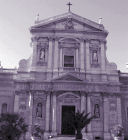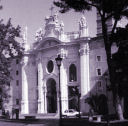
The Station is in the church of St. Susanna, virgin and martyr of Rome. The first Christian place of worship was built here in the 4th century. It was probably the titulus of Pope Caius (283-296). Caius was St. Susanna's uncle, and tradition claims that the church stands on the site of her martyrdom.
"God Loved the World", the title from MAGNFICAT (com) has been excerpted from Benedict XVI.
Below, the paragraphs emphasised....
Pope Benedict XVI 2009 April
WAY OF THE CROSS AT THE COLOSSEUM
ADDRESS OF HIS
HOLINESS BENEDICT XVI
Good Friday, 10
April 2009
Dear Brothers and Sisters,
At the end of his dramatic Passion
narrative, the Evangelist Saint Mark tells us: “The centurion, who stood facing
him, saw that he thus breathed his last, and said: ‘Truly this man was the Son
of God!’” (Mk 15:39). We cannot fail to be surprised by the
profession of faith of this Roman soldier, who had been present throughout the
various phases of the Crucifixion. When the darkness of night was falling on
that Friday so unlike any other in history, when the sacrifice of the Cross was
already consummated and the bystanders were making haste to celebrate the
Jewish Passover in the usual way, these few words, wrung from the lips of a
nameless commander in the Roman army, resounded through the silence that
surrounded that most singular death. This Roman army officer, having witnessed
the execution of one of countless condemned prisoners, was able to recognize in
this crucified man the Son of God, who had perished in the most humiliating
abandonment. His shameful end ought to have marked the definitive triumph of
hatred and death over love and life. But it was not so! Hanging from the Cross
on Golgotha was a man who was already dead, but that man was acknowledged to be
the “Son of God” by the centurion, “on seeing that he thus breathed his last”,
as the Evangelist specifies.
We are reminded of this soldier’s
profession of faith every time we listen anew to the Passion according to Saint
Mark. This evening, like the centurion, we pause to gaze on the lifeless face
of the Crucified One at the conclusion of this traditional Via Crucis which, through the radio
and television coverage, has brought many people together from every part of
the world. We have re-lived the tragic event of a man unique in the history of
all times, who changed the world not by killing others but by letting himself
be killed as he hung from a cross. This man, seemingly one of us, who while he
was being killed forgave his executioners, is the “Son of God”, who, as the
Apostle Paul reminds us, “did not count equality with God a thing to be
grasped, but emptied himself, taking the form of a servant … he humbled
himself, and became obedient unto death, even death on a cross” (Phil 2:7-8).
The anguish of the Passion of the
Lord Jesus cannot fail to move to pity even the most hardened hearts, as it
constitutes the climax of the revelation of God’s love for each of us. Saint
John observes: “God so loved the world that he gave his only Son, that whoever
believes in him should not perish, but have eternal life” (Jn 3:16).
It is for love of us that Christ dies on the cross! Throughout the course of
the millennia, a great multitude of men and women have been drawn deeply into
this mystery and they have followed him, making in their turn, like him and
with his help, a gift to others of their own lives. They are the saints and the
martyrs, many of whom remain unknown to us. Even in our own time, how many
people, in the silence of their daily lives, unite their sufferings with those
of the Crucified One and become apostles of a true spiritual and social
renewal! What would man be without Christ? Saint Augustine observes: “You would
still be in a state of wretchedness, had He not shown you mercy. You would not
have returned to life, had He not shared your death. You would have passed away
had He not come to your aid. You would be lost, had He not come” (Discourse 185:1).
So why not welcome him into our lives?
Let us pause ... to
contemplate his disfigured face: it is the face of the Man of sorrows, who took
upon himself the burden of all our mortal anguish. His face is reflected in
that of every person who is humiliated and offended, sick and suffering, alone,
abandoned and despised. Pouring out his blood, he has rescued us from the
slavery of death, he has broken the solitude of our tears, he has entered into
our every grief and our every anxiety.
Brothers and Sisters! As the Cross
rises up on Golgotha, the eyes of our faith are already turned towards the
dawning of the new Day, and we begin to taste the joy and splendour of Easter.
“If we have died with Christ”, writes Saint Paul, “we believe that we shall
also live with Him” (Rom 6:8). In this certainty, let us continue
our journey. Tomorrow, on Holy Saturday, we will watch and pray. And now, let
us pray together with Mary, the Sorrowful Virgin, let us pray with all who are
sorrowful, and especially with all the suffering people from the earthquake zone
in L’Aquila: let us pray that in this dark night, the star of hope will appear
also to them, the light of the Risen Lord.
I wish all of you, even now, a Happy
Easter in the light of the Risen Lord!
© Copyright 2009 - Libreria Editrice Vaticana
Stational Church  The Station at Rome is in the basilica of Holy Cross in Jerusalem, one of the seven principal churches of the holy city. It was built in the fourth century, by the emperor Constantine. The emperor's mother, St. Helen, enriched it with most precious relics, and wished to make it the Jerusalem of Rome.
The Station at Rome is in the basilica of Holy Cross in Jerusalem, one of the seven principal churches of the holy city. It was built in the fourth century, by the emperor Constantine. The emperor's mother, St. Helen, enriched it with most precious relics, and wished to make it the Jerusalem of Rome.

No comments:
Post a Comment